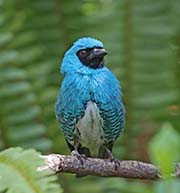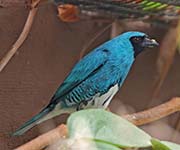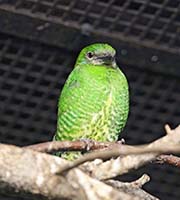Swallow Tanager - Tersina viridis
| Length | |
| Weight | |
| Clutch Size | |
| Chicks at birth | |
| IUCN Conservation Status | |
Continents: |
There are 3 subspecies of Swallow Tanagers in South America and Panama. They are sexually dimorphic. The male has a turquoise body, white belly and a black mask and throat. First year males are a more mottled green and they gradually assume the adult plumage around four years. (Males can breed in sub-adult plumage.) The female is a dull green with yellowish underparts.
Outside of breeding season, they are usually found in small flocks with others of their own species. In Brazil flocks of over 100 have been observed.
Diet: Swallow Tanagers eat fruit, berries and insects. The insects are consumed on-the-wing and berries are picked by hovering. Larger fruits, such as avocados, are manipulated in the mouth until the fleshy parts have been extracted and then the pit is ejected. Small fruits are swallowed whole.
Courtship: In Venezuela it was observed that courtship ritual included posturing, trembling with the wings and tail, bowing (curtsy reaction), and hopping and chasing. The female initiated pair formation and the male forms and defends a territory from other Swallow Tanagers and bird species.
Nesting: The male searches for the nest sites and the female selects one. Nest sites are cavities that are either man made (wall crevices, under bridges), naturally made or excavated (tree holes, cliffs). The female builds the nest which is a shallow cup lined with fine fibers. Usually, 3 porcelain white eggs are laid. Both parents feed the young.
Habitat and Range: They are found in Panama, much of the northern half of South America, south to southern Brazil. They inhabit open woodland, forest edges, second growth, clearings with trees and other riparian habitats.
Vocalization: Songs and calls are squeaky and unmusical. Only the males sing and they only sing while sitting still.
Plumage/Molt: No alternate plumage and probably molt annually like other tanagers.
Migration: Some Swallow Tanagers migrate. In the southern portions of their range, they migrate north. In northern South America, some may migrate in elevation.
Tongue/feet: Grey legs and feet.
Bibliography:
- Isler, Morton L. and Isler, Phyllis R., The Tanagers: Natural History, distribution, and Identification,Smithsonian Institution Press, Washington D.C., 1987
- http://neotropical.birds.cornell.edu/portal/home The Cornell Lab of Ornithoogy Neotropical Birds, Accessed June, 2013





